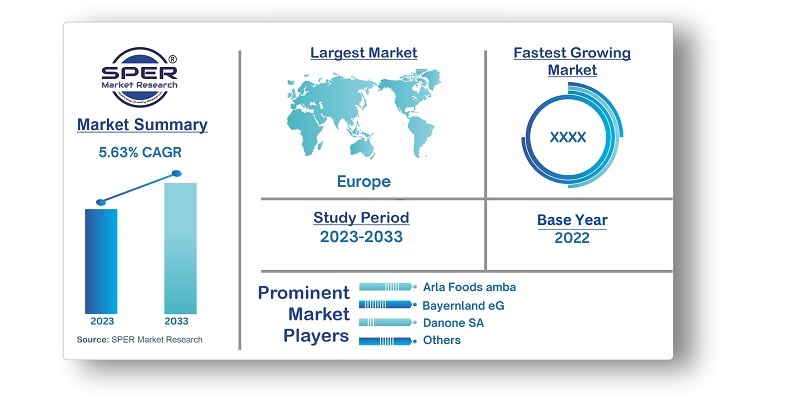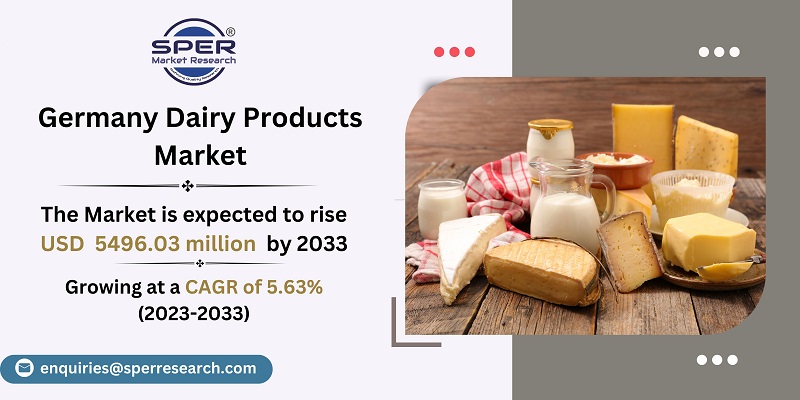
Germany Dairy Products Market Growth, Size, Trends, Demand, Revenue, Share and Future Outlook
Germany Dairy Products Market Size- By Category, By Distribution Channel- Regional Outlook, Competitive Strategies and Segment Forecast to 2033
| Published: Jan-2024 | Report ID: FOOD2402 | Pages: 1 - 107 | Formats*: |
| Category : Food & Beverages | |||
- Hochland Holding GmbH & Co. KG extended its dairy plants in February 2022 and made significant investments for which it released over USD 100 million.
- A contract to sell BMI's Fresh division, which includes the product groups Fresh Milk, Yoghurt, and other products, was signed in March 2022 by the Lactalis Group and Bayerische Milchindustrie eG (BMI). With this acquisition, Lactalis hopes to establish a close-knit relationship with the milk producers in southern Germany in order to grow the market for local goods in ethnic trade, national foodservice, and retail food.


| Report Metric | Details |
| Market size available for years | 2019-2033 |
| Base year considered | 2022 |
| Forecast period | 2023-2033 |
| Segments covered | By Category, By End User |
| Regions covered | Eastern Region, Western Region, Southern Region, Northern Region |
| Companies Covered | Arla Foods amba, Bayernland eG, Danone SA, DMK Deutsches Milchkontor GmbH, Frischli Milchwerke GmbH, Groupe Lactalis, Hochland Holding GmbH & Co. KG, Kruger Group, Muller Group, Saliter Milchwerk GmbH & Co. KG, Unilever PLC, and others |
- Consumers
- Retail and Wholesale Businesses
- Food and Beverage Industry
- Health and Fitness Industry
- Specialized Diets and Lifestyles
| By Category: |
|
| By Distribution Channel: |
|
| By Region: |
|
- Germany Dairy Products Market Size (FY’2023-FY’2033)
- Overview of Germany Dairy Products Market
- Segmentation of Germany Dairy Products Market By Category (Butter, Cheese, Cream, Dairy Desserts, Milk, Sour Milk Drinks, Yogurt)
- Segmentation of Germany Dairy Products Market By Distribution Channel (Convenience Stores, Online Retail, Specialist Retailers, Supermarkets and Hypermarkets, Others)
- Expansion Analysis of Germany Dairy Products Market
- Problems and Obstacles in Germany Dairy Products Market
- Competitive Landscape in the Germany Dairy Products Market
- Impact of COVID-19 and Demonetization on Germany Dairy Products Market
- Details on Current Investment in Germany Dairy Products Market
- Competitive Analysis of Germany Dairy Products Market
- Prominent Players in the Germany Dairy Products Market
- SWOT Analysis of Germany Dairy Products Market
- Germany Dairy Products Market Future Outlook and Projections (FY’2023-FY’2033)
- Recommendations from Analyst
1.1. Scope of the report1.2. Market segment analysis
2.1. Research data source2.1.1. Secondary Data2.1.2. Primary Data2.1.3. SPER’s internal database2.1.4. Premium insight from KOL’s2.2. Market size estimation2.2.1. Top-down and Bottom-up approach2.3. Data triangulation
4.1. Driver, Restraint, Opportunity and Challenges analysis4.1.1. Drivers4.1.2. Restraints4.1.3. Opportunities4.1.4. Challenges4.2. COVID-19 Impacts of the Germany Dairy Products Market
5.1. SWOT Analysis5.1.1. Strengths5.1.2. Weaknesses5.1.3. Opportunities5.1.4. Threats5.2. PESTEL Analysis5.2.1. Political Landscape5.2.2. Economic Landscape5.2.3. Social Landscape5.2.4. Technological Landscape5.2.5. Environmental Landscape5.2.6. Legal Landscape5.3. PORTER’s Five Forces5.3.1. Bargaining power of suppliers5.3.2. Bargaining power of buyers5.3.3. Threat of Substitute5.3.4. Threat of new entrant5.3.5. Competitive rivalry5.4. Heat Map Analysis
6.1. Germany Dairy Products Market Manufacturing Base Distribution, Sales Area, Product Type6.2. Mergers & Acquisitions, Partnerships, Product Launch, and Collaboration in Germany Dairy Products Market
7.1. Germany Dairy Products Market Value Share and Forecast, By Category, 2023-20337.2. Butter7.3. Cheese7.4. Cream7.5. Dairy Desserts7.6. Milk7.7. Sour Milk Drinks7.8. Yogurt
8.1. Germany Dairy Products Market Value Share and Forecast, By Distribution Channel, 2023-20338.2. Convenience Stores8.3. Online Retail8.4. Specialist Retailers8.5. Supermarkets and Hypermarkets8.6. Others
9.1. Germany Dairy Products Market Size and Market Share
10.1. Germany Dairy Products Market Size and Market Share By Category (2019-2026)10.2. Germany Dairy Products Market Size and Market Share By Category (2027-2033)
11.1. Germany Dairy Products Market Size and Market Share By Distribution Channel (2019-2026)11.2. Germany Dairy Products Market Size and Market Share By Distribution Channel (2027-2033)
12.1. Germany Dairy Products Market Size and Market Share By Region (2019-2026)12.2. Germany Dairy Products Market Size and Market Share By Region (2027-2033)12.3. Eastern Region12.4. Western Region12.5. Southern Region
12.6. Northern Region
13.1. Arla Foods amba13.1.1. Company details13.1.2. Financial outlook13.1.3. Product summary13.1.4. Recent developments13.2. Bayernland eG13.2.1. Company details13.2.2. Financial outlook13.2.3. Product summary13.2.4. Recent developments13.3. Danone SA13.3.1. Company details13.3.2. Financial outlook13.3.3. Product summary13.3.4. Recent developments13.4. DMK Deutsches Milchkontor GmbH13.4.1. Company details13.4.2. Financial outlook13.4.3. Product summary13.4.4. Recent developments13.5. Frischli Milchwerke GmbH13.5.1. Company details13.5.2. Financial outlook13.5.3. Product summary13.5.4. Recent developments13.6. Groupe Lactalis13.6.1. Company details13.6.2. Financial outlook13.6.3. Product summary13.6.4. Recent developments13.7. Hochland Holding GmbH & Co. KG13.7.1. Company details13.7.2. Financial outlook13.7.3. Product summary13.7.4. Recent developments13.8. Kruger Group13.8.1. Company details13.8.2. Financial outlook13.8.3. Product summary13.8.4. Recent developments13.9. Muller Group13.9.1. Company details13.9.2. Financial outlook13.9.3. Product summary13.9.4. Recent developments13.10. Saliter Milchwerk GmbH & Co. KG13.10.1. Company details13.10.2. Financial outlook13.10.3. Product summary13.10.4. Recent developments13.11. Unilever PLC13.11.1. Company details13.11.2. Financial outlook13.11.3. Product summary13.11.4. Recent developments13.12. Others
SPER Market Research’s methodology uses great emphasis on primary research to ensure that the market intelligence insights are up to date, reliable and accurate. Primary interviews are done with players involved in each phase of a supply chain to analyze the market forecasting. The secondary research method is used to help you fully understand how the future markets and the spending patterns look likes.
The report is based on in-depth qualitative and quantitative analysis of the Product Market. The quantitative analysis involves the application of various projection and sampling techniques. The qualitative analysis involves primary interviews, surveys, and vendor briefings. The data gathered as a result of these processes are validated through experts opinion. Our research methodology entails an ideal mixture of primary and secondary initiatives.



Frequently Asked Questions About This Report
PLACE AN ORDER
Year End Discount
Sample Report
Pre-Purchase Inquiry
NEED CUSTOMIZATION?
Request CustomizationCALL OR EMAIL US
100% Secure Payment






Related Reports
Our Global Clients
Our data-driven insights have influenced the strategy of 200+ reputed companies across the globe.




















